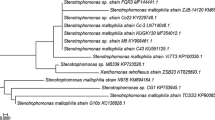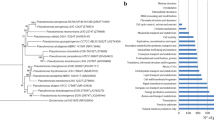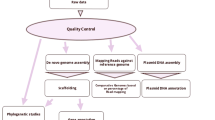Abstract
Pseudomonas sp. P11 was isolated from the industrial wastewater sediment nearby the Daye Non-ferrous Metals Company, China. This strain possesses the ability to resist various heavy metals and efficiently precipitate arsenic. We here present a summary classification and a set of features of Pseudomonas sp. P11, together with the description of the genomic sequencing and annotation. The genomic sequence is 6,644,817 bp with a G+C content of 62.20% and contains 6143 protein-coding genes, 250 pseudo genes, and 76 tRNAs/rRNAs genes. Operons and gene clusters responsible for multiple heavy metal tolerance or detoxification were identified and accounted for the observed resistance phenotypes. Phylogenetic analysis revealed that the paralogous arsenic resistant genes possess different evolutionary paths. This study provides important insights to illuminate the versatility and adaptation of this strain to the heavy metal-contaminated environment.





Similar content being viewed by others
References
Cánovas D, Cases I, de Lorenzo V (2003) Heavy metal tolerance and metal homeostasis in Pseudomonas putida as revealed by complete genome analysis. Environ Microbiol 5(12):1242–1256. https://doi.org/10.1046/j.1462-2920.2003.00463.x
Chen IA, Markowitz VM, Chu K, Palaniappan K, Szeto E, Pillay M, Ratner A, Huang J, Andersen E, Huntemann M, Varghese N, Hadjithomas M, Tennessen K, Nielsen T, Ivanova NN, Kyrpides NC (2017) IMG/M: integrated genome and metagenome comparative data analysis system. Nucleic Acids Res 45(D1):D507–D516. https://doi.org/10.1093/nar/gkw929
Chong TM, Yin WF, Chen JW, Mondy S, Grandclément C, Faure D, Dessaux Y, Chan KG (2016) Comprehensive genomic and phenotypic metal resistance profile of Pseudomonas putida strain S13.1.2 isolated from a vineyard soil. AMB Express 6(1):95. https://doi.org/10.1186/s13568-016-0269-x
Delcher AL, Bratke KA, Powers EC, Salzberg SL (2007) Identifying bacterial genes and endosymbiont DNA with Glimmer. Bioinformatics 23(6):673–679. https://doi.org/10.1093/bioinformatics/btm009
Enright AJ, Van Dongen S, Ouzounis CA (2008) An efficient algorithm for large-scale detection of protein families. Nucleic Acids Res 30(7):1575–1584
Fischer S, Brunk BP, Chen F, Gao X, Harb OS, Iodice JB, Shanmugam D, Roos DS, Stoeckert CJ Jr (2011) Using OrthoMCL to assign proteins to OrthoMCL-DB groups or to cluster proteomes into new ortholog groups. Curr Protoc Bioinformaticsr 35:6.12.1–6.12.19. https://doi.org/10.1002/0471250953.bi0612s35
Galperin MY, Maka COG, Rova KS, Wolf YI, Koonin EV (2015) Expanded microbial genome coverage and improved protein family annotation in the COG database. Nucleic Acids Res 43:261–269. https://doi.org/10.1093/nar/gku1223
Grant JR, Arantes AS, Stothard P (2012) Comparing thousands of circular genomes using the CGView comparison tool. BMC Genom 13:202. https://doi.org/10.1186/1471-2164-13-202
Hernández-Ramírez KC, Reyes-Gallegos RI, Chávez-Jacobo VM, Díaz-Magaña A, Meza-Carmen V, Ramírez-Díaz MI (2018) A plasmid-encoded mobile genetic element from Pseudomonas aeruginosa that confers heavy metal resistance and virulence. Plasmid 98:15–21. https://doi.org/10.1016/j.plasmid.2018.07.003
Kim OS, Cho YJ, Lee K, Yoon SH, Kim M, Na H, Park SC, Jeon YS, Lee JH, Yi H, Won S, Chun J (2012) Introducing EzTaxon-e: a prokaryotic 16S rRNA gene sequence database with phylotypes that represent uncultured species. Int J Syst Evol Microbiol 62:716–721. https://doi.org/10.1099/ijs.0.038075-0
Kumar S, Stecher G, Tamura K (2016) MEGA7: molecular evolutionary genetics analysis version 70 for bigger datasets. Mol Biol Evol 33(7):1870–1874. https://doi.org/10.1093/molbev/msw054
Lane DJ (1991) 16S/23S rRNA sequencing. In: Stackebrandt E, Goodfellow M (eds) Nucleic acid techniques in bacterial systematics. Wiley, Chichester, pp 115–175
Larkin MA, Blackshields G, Brown NP, Chenna R, McGettigan PA, McWilliam H, Valentin F, Wallace IM, Wilm A, Lopez R, Thompson JD, Gibson TJ, Higgins DG (2007) Clustal W and Clustal X version 2.0. Bioinformatics 23(21):2947–2948. https://doi.org/10.1093/bioinformatics/btm404
Lu M, Jiao S, Gao E, Song X, Li Z, Hao X, Rensing C, Wei G (2017) Transcriptome response to heavy metals in Sinorhizobium meliloti CCNWSX0020 reveals new metal resistance determinants that also promote bioremediation by Medicago lupulina in metal-contaminated soil. Appl Environ Microbiol 83(20):e01244-17. https://doi.org/10.1128/AEM.01244-17
Marmur J, Doty P (1961) Thermal renaturation of deoxyribonucleic acids. J Mol Biol 3(5):585–594
Masood F, Malik A (2013) Current aspects of metal resistant bacteria in bioremediation: from genes to ecosystem. In: Abdul M, Elisabeth G, Madalena A (eds) Management of microbial resources in the environment. Springer, Dordrecht, pp 289–311
Ma Y, Rajkumar M, Moreno A, Zhang C, Freitas H (2017) Serpentine endophytic bacterium Pseudomonas azotoformans ASS1 accelerates phytoremediation of soil metals under drought stress. Chemosphere 185:75–85. https://doi.org/10.1016/j.chemosphere.2017.06.135
Migula W (1894) Uber ein neues system der bakterien. Arb Bakteriol Inst Karlsruhe 1:235–238
Moreno-Hagelsieb G, Latimer K (2008) Choosing BLAST options for better detection of orthologs as reciprocal best hits. Bioinformatics 24(3):319–324. https://doi.org/10.1093/bioinformatics/btm585
Peix A, Ramírez-Bahena MH, Velázquez E (2018) The current status on the taxonomy of Pseudomonas revisited: an update. Infect Genet Evol 57:106–116. https://doi.org/10.1016/j.meegid.2017.10.026
Pitondo-Silva A, Gonçalves GB, Stehling EG (2016) Heavy metal resistance and virulence profile in Pseudomonas aeruginosa isolated from Brazilian soils. APMIS 124(8):681–688. https://doi.org/10.1111/apm.12553
Roosa S, Wauven CV, Billon G, Matthijs S, Wattiez R, Gillan DC (2014) The Pseudomonas community in metal-contaminated sediments as revealed by quantitative PCR: a link with metal bioavailability. Res Microbiol 165(8):647–656. https://doi.org/10.1016/j.resmic.2014.07.011
Smibert RM, Krieg NR (1994) Phenotypic characterization. In: Gerhart P, Murray RGE, Wood WA, Krieg NR (eds) Methods for general and molecular bacteriology. American Society for Microbiology, Washington, DC, pp 607–654
Tatusova T, Dicuccio M, Badretdin A, Chetvernin V, Nawrocki EP, Zaslavsky L, Lomsadze A, Pruitt KD, Borodovsky M, Ostell J (2016) NCBI prokaryotic genome annotation pipeline. Nucleic Acids Res 44(14):6614–6624. https://doi.org/10.1093/nar/gkw569
Voica DM, Bartha L, Banciu HL, Oren A (2016) Heavy metal resistance in halophilic Bacteria and Archaea. FEMS Microbiol Lett 363(14):45. https://doi.org/10.1093/femsle/fnw146
Yang G, Han L, Wen J, Zhou S (2013) Pseudomonas guangdongensis sp. nov., isolated from an electroactive biofilm, and emended description of the genus Pseudomonas Migula 1894. Int J Syst Evol Microbiol 63:4599–4605. https://doi.org/10.1099/ijs.0.054676-0
Zerbino DR, Birney E (2008) Velvet: algorithms for de novo short read assembly using de Bruijn graphs. Genome Res 18(5):821–829. https://doi.org/10.1101/gr.074492.107
Acknowledgements
This work was financially supported by the Natural Science Foundation of Hubei Province, China (Grant No. 2012FFB01804).
Author information
Authors and Affiliations
Corresponding author
Ethics declarations
Conflict of interest
The authors declare that they have no conflicts of interest.
Additional information
Publisher's Note
Springer Nature remains neutral with regard to jurisdictional claims in published maps and institutional affiliations.
Rights and permissions
About this article
Cite this article
Yan, Z., Li, M., Wang, J. et al. Genome Analysis Revealing the Potential Mechanisms for the Heavy Metal Resistance of Pseudomonas sp. P11, Isolated from Industrial Wastewater Sediment. Curr Microbiol 76, 1361–1368 (2019). https://doi.org/10.1007/s00284-019-01728-2
Received:
Accepted:
Published:
Issue Date:
DOI: https://doi.org/10.1007/s00284-019-01728-2




